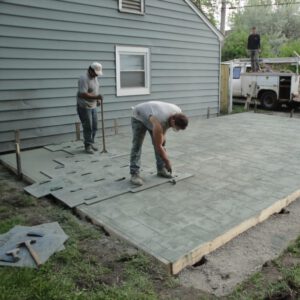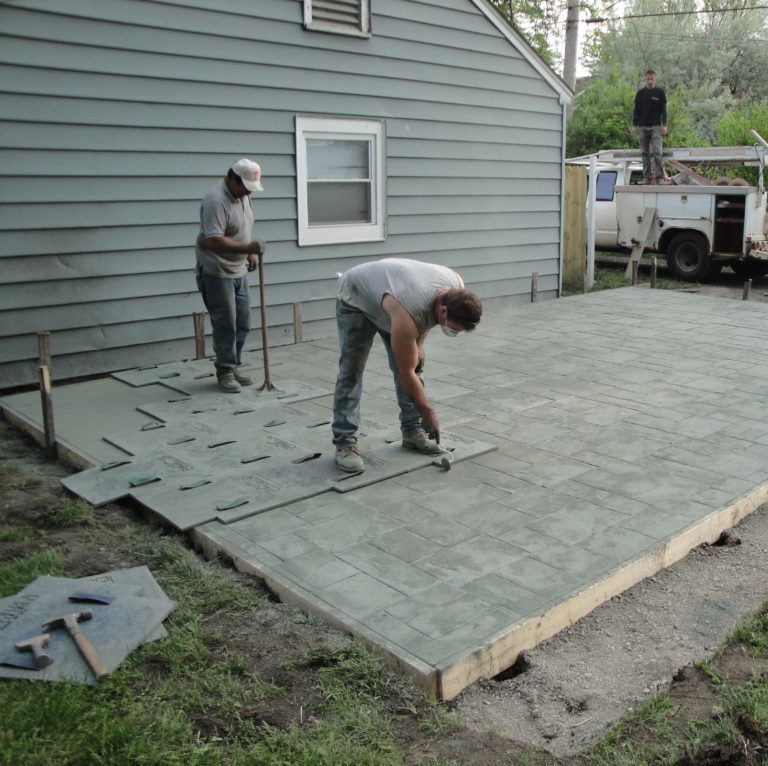Stamped concrete is a durable and attractive way to decorate your home. Its texture and color variations allow you to create any pattern you like. Stamped Concrete can be made to resemble various building materials, including brick, natural stone, and brick veneer. If you want a more subtle design, consider using less-textured concrete. In the end, it’s entirely up to you. Stamped concrete is a great way to enhance your home’s value.
 To create the desired patterns, you need to apply color-release material. This substance comes in two forms: liquid and powder. The cast-on color release uses calcium-releasing powders that repel water. The liquid color release uses an aromatic-based solvent. It is spread over the concrete surface before stamping. Liquid color release is sprayed on the bottom of the concrete stamp. The color-release material makes the concrete look durable. You can then use it to create the patterns you want.
To create the desired patterns, you need to apply color-release material. This substance comes in two forms: liquid and powder. The cast-on color release uses calcium-releasing powders that repel water. The liquid color release uses an aromatic-based solvent. It is spread over the concrete surface before stamping. Liquid color release is sprayed on the bottom of the concrete stamp. The color-release material makes the concrete look durable. You can then use it to create the patterns you want.
The cost of stamped concrete tools can be prohibitive. However, the price is worth it if you plan to use them on several projects. A do-it-yourselfer should be aware of these costs. Stamped concrete tools are not for everyone. It requires a certain level of skill to use them. However, if you have experience with other concrete projects, you can save a considerable amount of money by hiring a professional.
When applying color, be sure to use a good quality sealant. Applying sealant can cause the colored concrete to peel over time. Many professionals recommend powdering the color before pouring to prevent peeling. You can also apply color additives to the concrete mixture before it is poured to create a unique look. After applying the sealant, allow the concrete to dry for at least 24 hours before using it. Then, it is time to begin stamping.
Decorative stamped concrete is less expensive than other surface materials. It is easier to install and requires less upkeep. Compared to natural stone and pavers, it is faster. Stamped concrete is less expensive, but it may not be the best choice for heavy-duty driveways or patios. However, it does increase the value of your home. A stone-coated driveway or patio can add thousands to its value. It is also easier to clean and less expensive to maintain compared to poured concrete.
One disadvantage of stamped concrete is its tendency to crack after installation. Minor cracks, however, blend in with the pattern and joint lines, making them difficult to disguise. If you notice cracks, you may need to patch the concrete patch with a different color or use another material altogether. In that case, you will need to redo the whole project. Stamped concrete also tends to fade over time, so periodic cleaning and sealing can minimize cracking.
You can choose to use a different pattern for your patio. For example, you could use a brick effect concrete stamp to create a natural-looking brick pattern. In the same way, you could choose to use an aged wood pattern for the patio. Besides being durable, it looks great, too. Stamped concrete can also create a rustic or tropical feel in your home. While it is not for the beginner, it is an excellent choice for anyone who wants to create a stunning outdoor area.
Another type of concrete, stamped concrete, can mimic brick, stone, and tile. Its design will look like those materials and will require less maintenance than other materials. Furthermore, colored stamped concrete is weather resistant and durable. It can be used for outdoor paving, courtyards, and pool decks. A few guidelines are necessary for the installation process. Make sure to compact the base before applying the stamped concrete since a properly compacted base is essential for the finished product.
In addition to the concrete color, Stamped Concrete also uses an accent color. This accent color adds texture to the concrete and can also serve to show off additional building materials. The accent color is created by applying a special substance called a color release to the concrete. The color release serves two purposes – one is a pigment, and the other is non-adhesive. Therefore, the stamps cannot stick to the surface, making them aesthetically pleasing.

